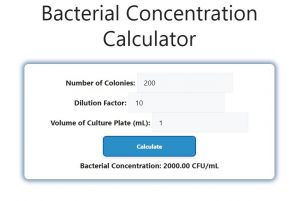About Bacterial Concentration Calculator (Formula)
A Bacterial Concentration Calculator is a valuable tool in microbiology for calculating the concentration of bacterial cells in a solution. By using simple inputs, this tool provides researchers with accurate bacterial counts, aiding in experiments, diagnostics, and research applications. Accurate bacterial concentration data is essential in studies requiring precise microbial quantification.
Formula
The formula to calculate bacterial concentration (BC) is:
BC = (Concentration × Dilution Factor) / Volume Counted
Where:
- C is the concentration in cells per unit volume (often CFU/mL),
- DF is the dilution factor,
- VC is the volume counted.
How to Use
To use a Bacterial Concentration Calculator, follow these steps:
- Input the observed bacterial concentration from your sample.
- Enter the dilution factor used during sample preparation.
- Provide the volume of the sample that was analyzed.
- The calculator will then output the bacterial concentration in CFU/mL or other specified units.
Example
Suppose you observed a bacterial concentration of 200 CFU/mL in a sample, with a dilution factor of 10 and a volume counted of 1 mL. Applying the formula:
- BC = (200 × 10) / 1
- BC = 2,000 CFU/mL
This result indicates a bacterial concentration of 2,000 CFU/mL in the original sample.

FAQs
1. What is a Bacterial Concentration Calculator?
A Bacterial Concentration Calculator helps estimate bacterial concentration in a solution, commonly used in microbiological studies.
2. Why is calculating bacterial concentration important?
Bacterial concentration is crucial for experiments requiring precise bacterial counts, such as drug efficacy testing or contamination analysis.
3. What does CFU/mL mean?
CFU/mL stands for “colony-forming units per milliliter,” a unit indicating the number of viable bacteria in a sample.
4. Can I use this calculator for all bacterial types?
Yes, it can be used for any bacterial type as long as the input values are accurately measured.
5. What is the dilution factor in bacterial concentration calculation?
The dilution factor represents how much the original sample was diluted during preparation to achieve a countable bacterial concentration.
6. How accurate is the bacterial concentration calculator?
The calculator’s accuracy depends on precise input values, especially the bacterial count and dilution factor.
7. What volume should I use in the formula?
The volume counted should be the specific volume of the sample analyzed to obtain the bacterial count.
8. How can I measure bacterial concentration without a calculator?
You can manually apply the formula, but a calculator simplifies and speeds up the process, reducing potential errors.
9. Is this calculator only for laboratory use?
Primarily, yes, as it’s designed for lab-based applications, but it may also be used in educational settings.
10. Why is dilution used in bacterial concentration calculations?
Dilution helps make the bacterial concentration manageable by reducing colony crowding, allowing for more accurate counting.
11. What types of samples can this calculator be used on?
This calculator is commonly used on liquid samples, including water, biological fluids, and bacterial cultures.
12. Does this calculator work for other microorganisms?
Yes, it can calculate concentration for other microorganisms if the inputs are prepared similarly.
13. What happens if I count too few or too many colonies?
A very low or high count can reduce accuracy; ideally, colony counts should be within a range that allows for accurate calculation.
14. Can I use any units for concentration?
Most bacterial concentrations are measured in CFU/mL, but the calculator can adapt to similar units if consistent throughout.
15. How do I determine the correct dilution factor?
The dilution factor depends on how many times you dilute the sample, with each dilution step typically doubling or tripling the factor.
16. What is a reasonable range for bacterial concentration?
Generally, a countable range is between 30 to 300 CFU/mL, but this depends on the study requirements.
17. Can this calculation indicate contamination levels?
Yes, bacterial concentration data can help assess contamination, especially in water or food testing.
18. Is it possible to overestimate bacterial concentration?
Yes, if samples are inaccurately diluted or counted, overestimation can occur.
19. How does the calculator handle decimal values?
The calculator can handle decimals, which is helpful for precise scientific measurements.
20. Can I use this calculator for environmental sampling?
Absolutely, as environmental sampling often requires bacterial quantification for safety analysis.
Conclusion
A Bacterial Concentration Calculator is an essential tool for microbiologists and researchers who need quick and reliable bacterial counts. By inputting basic measurements, this calculator provides a precise bacterial concentration reading, making it ideal for various applications, from lab experiments to environmental testing. Properly applied, it ensures effective monitoring of microbial activity and contamination in a wide array of samples.